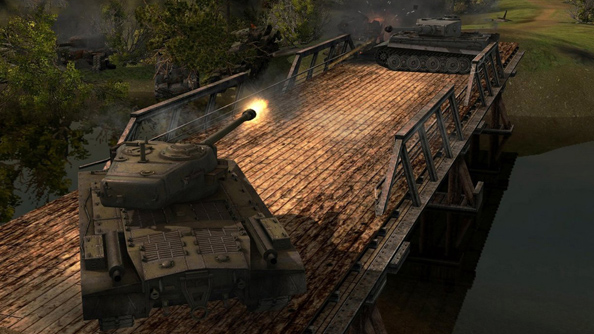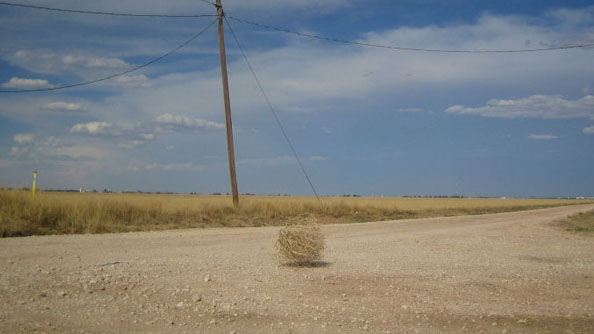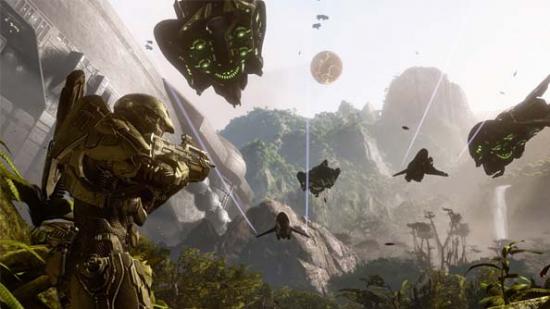We’re always courting controversy here at PCGamesN. Tim once had five Aspirin in a day when the box said four was the limit; and, Paul: Paul thinks manhole covers keep the ocean from pouring forth in geysers; Jeremy’s mostly normal, though I’ve not known him to make it all the way through a shift sober. But, until now, our weekly playlist hasn’t reflected this dangerously counter-cultural streak: this week Tim’s been playing Halo 4 *spit* and Rob’s played thing. Nothing.
Tim Edwards: Halo 4
Halo 4.
Don’t shoot me.
It would be ludicrous to pretend that any of us don’t play console games. So, I’m going to ‘fess up and say that the latest Halo has been gripping me pretty fiercely.
It’s interesting, though, to play it with one eye on the PC, and what could have been. In many ways, I’m hugely disappointed that I couldn’t play it on PC.
Halo 4 is an undeniably pretty game. The developers and programmers working on it have done astonishing work to make the tech from Reach look close to a next-generation title. It is, to my eyes, the best looking console game around right now. The lighting engine is superb, terrain detail is a step above what we’ve played before and the particle effects, one of the highlights of the Halo games, are as stunning as ever.
Halo 4 looks close to what I expect a next-generation console will look like. Close, but not quite.
But, there’s a problem. Alongside Halo 4’s single player campaign is something called “Spartan Ops”.
Think of Spartan Ops as the game’s extremely polished episodic Horde mode. Each week, 343 will pump out a group of wide arenas in which teams of up to four can co-operate to bring down baddies.
Here’s the problem: the XBox can’t cope with it.
Halo has always been at its best when it pushes players into battles of extraordinary scale. The bits I remember and love from the Halo games are extremes: the glorious beach landing and sense of space from Halo 1’s Assault on the Control Room. The demented attack on two scarabs from Halo 3. The brilliant attack on the aerial guns in Reach. And, whisper it, the open worlds of the quietly under-rated Halo: ODST.
Halo 4 doesn’t do the same scale. As Mike Gapper points out in his review for CVG, Halo 4’s tech prowess comes at the expense of width: levels are tighter, thinner, and just have much less going on.
Spartan Ops, as a pure co-op mode, tries to render the kind of scenes that were the highlight of previous Halos, but just can’t. The levels are plainer. Beyond a certain range, the baddies disappear; they’re turned into 2D arrows to remind you where they were. It’s a baffling moment: a game renowned for its scale just giving up, handing in the towel. “Nope,” says the XBox. “Can’t render him. Too hard.” I’m surprised this failing isn’t getting more press.
This is where I come to the PC bit. I completely understand that 343 are working to specific constraints: it’s inevitable. But one of the fun things about working within the PC is that games get better with age; as newer hardware appears, you’re able to ramp up draw distances, detail levels, and more. The ArmA 2 of today looks much better than the ArmA 2 of launch. So does GTA 4. So does World of Warcraft, or Total War, or anything, really.
This is why I’m sad. Halo 4’s Spartan Ops will never reach its potential. We’ll probably never be able to see what it could be like with improved hardware. That feels like a crying shame.

Paul Dean: World of Tanks (again!)
I have a terrible problem in- Oh God, I’m sorry! …I have a terrible problem in World of Tanks, and that is- Oh no! No, it’s fine! …Okay, my problem is that I’m- OH JESUS SORRY there wasn’t a dog in there, was there? Let me just OH CRIPES hello, sorry, I was just trying to reverse because of… No, not into your living room, no, but away. Away from everything.
My problem is that I’m terrified of driving into things. I just can’t bear to destroy the scenery, even if it’s in my own interest, and since so much of the scenery in World of Tanks can be blown up, driven over or ploughed through, this means I nervously nuzzle my way through farms and villages and towns, always being as cautious as I can when I make a turning and always doing my very best to keep to the main roads and away from everyone’s homes.
Trees are okay, I guess. I don’t mind knocking down the odd tree here and there, but it’s the property damage that really gets me, not just how easy it is to commit, but the sheer variety of it that’s possible. It’s all too easy to smash your tank into someone’s kitchen, all to easy to drive through their garden wall, crush their fences, level their doghouse, destroy their tractors and their wagons and even their favourite cars. One map even features graves that you can crush under your tracks, for heaven’s sake.
I’m not so strange, I see everybody doing it. Other tankers who could save time by making a beeline through someone’s bedroom instead circle around a house, keep to the roads, drive through gates instead of walls. I know I’m not the only one who wants there to be something left of the maps that we’re fighting so fiercely for.
Jeremy Peel: Total War Battles: Shogun
You’d think it turn-based, to glance at that screenshot there. It’s not. I’d call it a treacle-paced RTS, but even then I can see StarCraft shapes forming in your mind’s eye – shapes that look nothing like Total War Battles: Shogun. Let me explain.
Total War Battles was an iPhone game first, for about a week. It’s the first fruit of Creative Assembly’s “mid-core” strategy. Built by a team tasked with making Netbook, laptop and Microsoft Surface-suitable games, it’s low-tech and designed to be played on the move.
Essentially it’s a checkers board, creaking under the weight of RTS elements that don’t belong – placeable buildings, resource management and numerous unit types. Units move simultaneously, but slowly. You can tell them to stop, start, and suggest which of the two hexes ahead of them they take next, but there’s no button on the UI to ask them to fall back. The result is an ever-evolving battlefront, of inevitable collisions and heroic, needless ends.
Meanwhile, you’ll be fumbling about at the feet of your precious general, desperately attempting to find space for a barracks to build pikemen to counter the cavalry trundling its ceaseless way down the board towards you.
Is it good? That remains to be seen – the campaign mode thus far has treated me like one of its units, carefully directing my attention, steering me towards understanding without ever allowing me to make a step back. But it is brave, and new. Commendably so.

Rob Zacny: None
This week I’m playing, “Oh my God, my travel arrangements have fallen apart and now I’m stuck in San Francisco for two days with nowhere to stay.” Not a lot of gaming is going to happen from this cheap hotel room, I’m afraid, as I try to do work on the worst internet connection I’ve seen since my days of spending three hours waiting for Napster to cough up a music track.
But I have had time to think, and I noticed something strange last night: I am far more tuned into the experience of being in the world when I’m away from home, when my surroundings are unfamiliar and I am alone. It reminds me partly of why I play games, and why I am so drawn to “immersive sims” that are as much about navigating and exploring a new world as they are about killing bad guys and sneaking past security.
In a way, it makes me a little sad. I love my adopted hometown of Boston, but I don’t see the buildings as much anymore, or taste the air, or hear the accents of the people around me. It’s that tendency we all have to become so acclimated to our own lives that we scarcely notice the details that give them their texture.
But scrambling to salvage a disastrous weekend in a different city, I’m abruptly aware of every little thing around me. I’m engaged with my surroundings, not just treating them like scenery for circular thoughts about work and obligations.
I wish I could do this more. But I realized last night that I had much the same feeling when I was playing Dishonored, and spent over an hour navigating my way through Dunwall’s bleak alleys and across Sokolov’s Bridge. It’s not just that games like Dishonored or STALKER give us exciting worlds to explore, but that they remind us what it is to be fully present in one.
